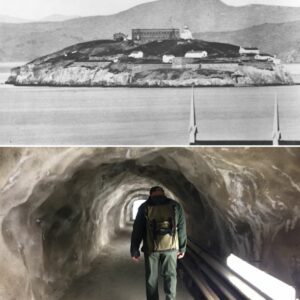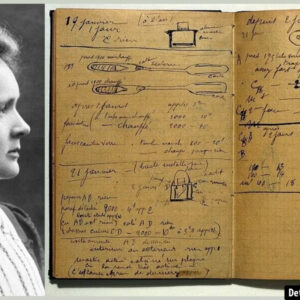In the vast expanse of Turkmenistan’s Karakum Desert, an extraordinary and otherworldly phenomenon known as the Darvaza Gas Crater has captivated the attention of adventurers, scientists, and tourists alike. With its relentless flames flickering endlessly beneath the desert sky, the crater has earned the moniker “Door to Hell.” What began as an industrial accident in 1971 has since become a symbol of nature’s power and the unpredictability of human innovation. This fiery pit, continuously burning for decades, has become an iconic landmark of Turkmenistan, a rare geological curiosity and a testament to the energy of the earth below.
Origins and Creation: How the ‘Door to Hell’ Was Born
The story of the Darvaza Gas Crater’s creation is shrouded in mystery, with various theories and conflicting accounts regarding its origins. The most widely accepted version traces its roots to a Soviet exploration team in the early 1970s. The team, in search of natural gas, drilled into the earth’s surface near the village of Darvaza, unintentionally triggering a collapse of a vast natural gas cavern beneath the surface. The resulting crater, which measured 70 meters wide and 30 meters deep, became a fiery spectacle as methane gas began escaping from the pit.

In a bid to prevent the dangerous release of toxic gases into the atmosphere, the Soviet engineers made the decision to ignite the gas. Their hope was that the fire would burn itself out in a few weeks. However, this would not be the case. The sheer volume of gas in the cavern ensured that the flames would continue to burn for decades, with no end in sight.
Video
Check out the video How the Soviets accidentally discovered the ‘Gates of Hell’ by BBC REEL to learn more about this fascinating story. Don’t miss it!
The Fiery Phenomenon: Science Behind the Flames
The Darvaza Gas Crater is not just a stunning visual spectacle but a natural phenomenon driven by the properties of methane gas. Methane, a highly combustible gas, is trapped beneath the desert floor in natural reservoirs. As gas escapes through the cracks and fissures in the earth’s surface, it meets the ignition source—the flames already burning—and sustains the fire. The continuous, controlled combustion creates the eerie, glowing pit visible from miles away.
At night, the crater becomes an even more mesmerizing sight. The flames light up the surrounding desert, casting an otherworldly glow across the barren landscape. Visitors standing on the rim of the crater feel the intense heat radiating from the depths below, a reminder of the immense power of nature and the mysteries that lie hidden in the earth’s crust.
Darvaza as a Tourist Destination: Transformation and Growth

What was once an industrial accident has since been transformed into one of Turkmenistan’s most famous tourist attractions. After the dissolution of the Soviet Union, the Darvaza Gas Crater gained international recognition as one of the most bizarre and captivating landmarks in the world. Over the years, it has drawn travelers and curious adventurers from across the globe who seek to witness this fiery spectacle firsthand.
Today, the area around the crater has been developed to accommodate visitors. Traditional yurts are set up nearby, allowing tourists to stay overnight and watch the flames dance under the starlit sky. In 2018, the crater even served as a stop for the Amul-Hazar automobile rally, further cementing its status as a must-see location.
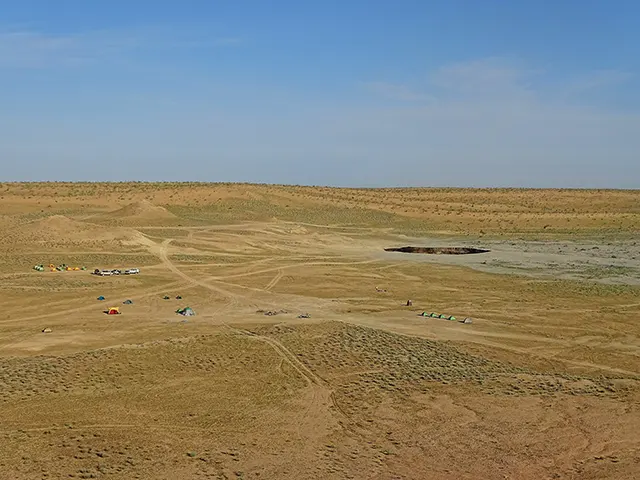
Safety Measures and Visitor Experience
Despite its appeal as a tourist destination, the Darvaza Gas Crater is also a dangerous site, and safety measures have been implemented to ensure visitors can enjoy the experience without undue risk. In 2018, a safety fence was installed around the crater, preventing visitors from getting too close to the flames. This fencing ensures that visitors can marvel at the fiery spectacle from a safe distance, offering a remarkable view of the crater’s terrifying beauty without the risk of falling in.
For those looking to experience the crater’s allure more intimately, several camps are available nearby, where travelers can rest and learn about the history and significance of the site. The camps also provide access to guides and transport for those wishing to explore the surrounding desert landscape.
Environmental and Economic Debate: Should the Flames be Extinguished?
While the Darvaza Gas Crater draws fascination from visitors worldwide, it has also sparked significant debates about its environmental impact. In 2010, President Gurbanguly Berdimuhamedow called for efforts to mitigate the environmental harm caused by the flames. This led to plans to extinguish the flames, with concerns about the potential ecological damage, the health risks posed by the emission of gases, and the long-term economic impact on the country’s natural gas industry.
Despite these efforts, the flames of the Darvaza Gas Crater continue to burn, with no clear solution in sight. Some experts argue that the fire should remain burning, as it has become an important symbol of Turkmenistan’s natural resources and an economic asset for the country. Others contend that extinguishing the flames is necessary for the preservation of the environment and the safety of local communities. The debate surrounding the fate of the crater continues to this day.
Explorers and Researchers: Descending Into the Crater
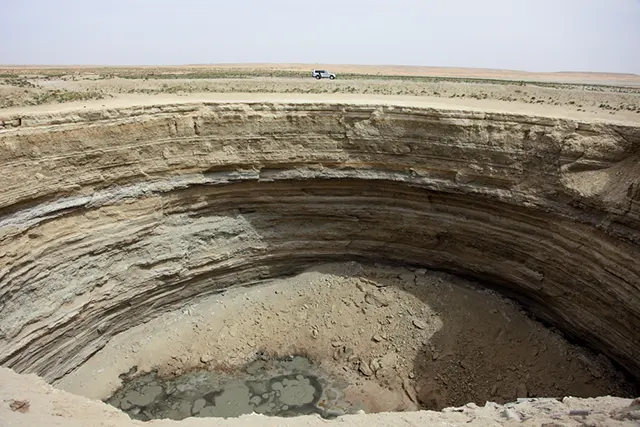
The Darvaza Gas Crater is not just a tourist attraction; it has also become the subject of scientific exploration. In 2013, renowned explorer George Kourounis became the first person to descend into the fiery pit. His mission, conducted as part of the Extreme Microbiome Project, involved collecting soil samples to study microorganisms capable of surviving in extreme conditions.
Equipped with a specially designed Kevlar harness, ropes, and a full-body aluminized suit, Kourounis braved the intense heat and hazardous gases to reach the bottom of the crater. His descent, sponsored by National Geographic, was featured in the documentary series Die Trying. Kourounis’s journey marked a new chapter in the exploration of one of the world’s most extraordinary natural phenomena.
Practical Guide: Visiting the Door to Hell
For those planning to visit the Darvaza Gas Crater, there are a few practical considerations to keep in mind. The site is located in a remote part of the Karakum Desert, and the journey requires careful preparation. Visitors should bring sufficient water, food, and supplies for the trip, as well as adequate protection from the extreme desert heat.
A rough, unmarked road leads to the crater, and although there are few facilities, visitors can stay in traditional yurts or tents provided by local operators. For those seeking a more comfortable experience, motorized transport can be arranged, allowing visitors to approach the crater without the need for long walks across the desert.

Darvaza’s Cultural and Symbolic Significance
Beyond its scientific and tourist value, the Darvaza Gas Crater holds symbolic significance in Turkmen culture. Known as the “Gates of Hell,” the fiery pit has become a modern-day representation of the power and unpredictability of nature. It is seen by some as a metaphor for the earth’s raw and untamed energy, while others view it as a reminder of human ingenuity and the unintended consequences of industrial exploration.
Photo Gallery: The Door to Hell in Stunning Images
To fully appreciate the grandeur of the Darvaza Gas Crater, one must witness its mesmerizing glow and the surrounding desert landscape. In this gallery, we present breathtaking images of the crater, captured by photographers who have ventured to this fiery wonder of the natural world. From the towering flames to the vast, barren desert, these photos capture the unique and haunting beauty of the “Door to Hell.”










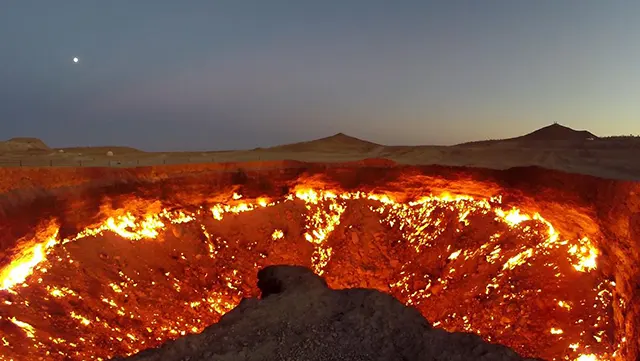
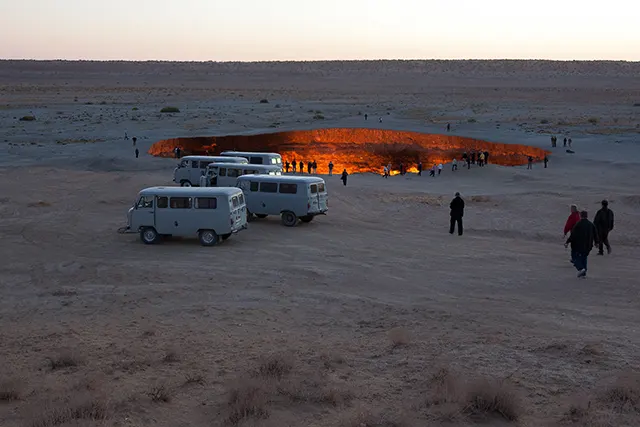


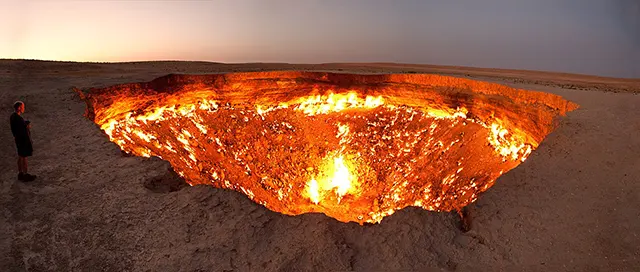
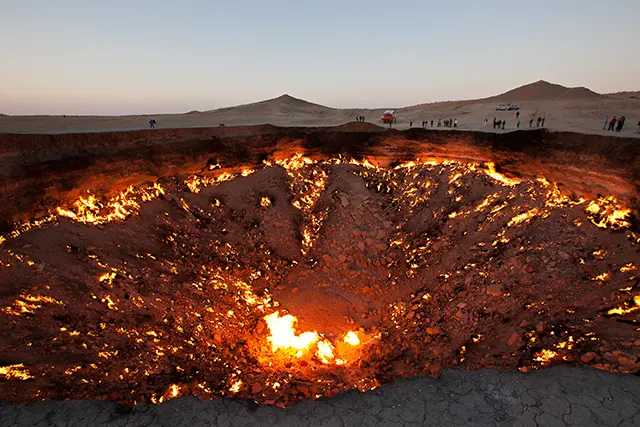
Video
Watch the video The Gateway to Hell May Soon Be Closed to find out what might happen next with this fiery landmark. Be sure to check it out!
Conclusion
The Darvaza Gas Crater is an extraordinary example of nature’s power and humanity’s sometimes unexpected impact on the environment. What began as an industrial accident has now become a symbol of both natural beauty and human curiosity, drawing visitors from across the world to witness the awe-inspiring sight of a fire that has burned for decades. Whether as a tourist destination, a subject of scientific research, or a symbol of Turkmenistan’s natural resources, the Darvaza Gas Crater remains an enigmatic and captivating phenomenon—one that continues to intrigue and inspire people everywhere.

